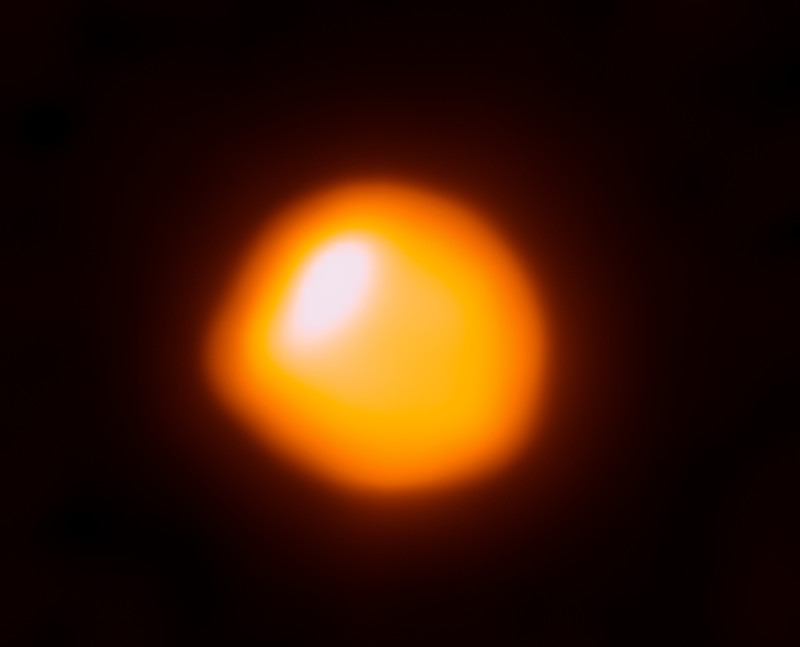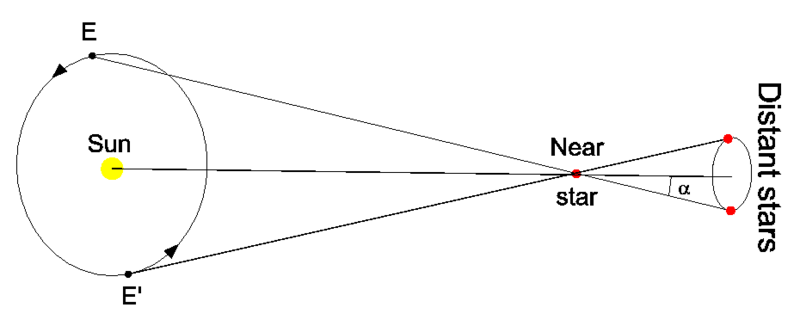
How far away is doomed Betelgeuse?
Betelgeuse, the bright red star in the constellation Orion the Hunter, is in the end stage of its stellar life. Someday, it will explode as a supernova. In late 2019 and early 2020, Betelgeuse suddenly and unexpectedly dimmed. Some joked it might soon explode! It didn’t, but still … what if it did? When Betelgeuse goes supernova, will it affect earthly life? How far away is Betelgeuse?
The good news is that if Betelgeuse explodes, it is close enough to put on a spectacular light show but far enough to not cause us on Earth any harm. To answer the distance question first, Betelgeuse is approximately 724 light-years away. But getting that answer, even for a relatively nearby star, is surprisingly difficult.
New measurement techniques
It’s only in the last 30 years that astronomers have obtained more accurate measurements for the distance to Betelgeuse and other nearby stars. New technologies explain this advance. It began in 1989, when the European Space Agency (ESA) launched a space telescope called Hipparcos, named after the famous Greek astronomer Hipparchus. Over several years of observations, the Hipparcos space telescope provided parallax and distance data for more than 100,000 relatively nearby stars.
Those measurements became the basis for most of the estimated distances to stars that you see today.
The original Hipparcos data gave a parallax of 7.63 milliarcseconds for Betelgeuse; that’s about one-millionth the width of the full moon. Computations based on that parallax yielded a distance of about 430 light-years.

Measurement errors
But Betelgeuse is what’s known as a variable star. That means its brightness fluctuates with time. That said, the excitement over Betelgeuse’s dimming was because it was the biggest dip in brightness ever observed. And therein began the difficulty in estimating Betelgeuse’s distance.
Subsequent studies found an error in the methods used for reducing the Hipparcos data for variable stars. An effort to correct those errors gave a parallax of 5.07 milliarcseconds. That changed Betelgeuse’s estimated distance from 430 light-years to about 643 light-years, plus or minus 46 light-years.
But wait, there’s more. In 2017, astronomers published new calculations that further refined Betelgeuse’s parallax to 4.51 milliarcseconds. This new analysis of data from Hipparcos also included observations from several ground-based radio telescopes. That placed Betelgeuse at a distance of about 724 light-years, or, more accurately, between 613 and 881 light-years, when data uncertainties are included.
Why Gaia can’t measure the distance of Betelgeuse
You might know that the European Space Agency’s Gaia astrometry mission has the goal of making a three-dimensional map of our Milky Way galaxy. With Gaia’s 3rd data release in June 2022, ESA said it now had estimates for nearly 2 billion stars in the galaxy.
Yet Betelgeuse is not one of those stars, and astronomers can’t use Gaia to find a more precise distance for Betelgeuse. The reason is that Betelgeuse is too bright for the spacecraft’s sensors.

More about parallax
Have you ever viewed a nearby object from two different locations and noticed how its position changed with respect to distant landmarks? That is the effect called parallax. Astronomers obtain measurements of a nearby star’s position in the sky relative to distant background stars six months apart. During that time, Earth has traveled to the opposite side of its orbit. Thus, two locations are about 186 million miles (300 million km) apart, or the diameter of Earth’s orbit. The difference in the nearby star’s relative position at the two locations enables astronomers to derive a parallax angle and calculate a distance to the nearby star.
Ancient Greek astronomers understood the concept of parallax, but they lacked the technology to make very fine angular measurements on the sky. As a result, all measurements of stellar parallax failed until German astronomer Friedrich Bessel succeeded in 1838. He used a telescope, and even though his two observing locations were on opposite sides of Earth’s orbit, he was barely able to make out a tiny angular displacement. But it was enough to determine a distance of 11 light-years to the nearby star 61 Cygni.
Limits of using parallax
From Bessel’s time until Hipparcos’ launch in 1989, astronomers compiled only a few thousand parallaxes. The process was difficult for a number of factors. The extremely small angles involved, imperfections in the instruments, and the murkiness of Earth’s own atmosphere all hinder measurements. The atmosphere distorts observations from the Earth, even from very clear and dark locations such as deserts and mountaintops.
Hipparcos, in obtaining observations from space starting in 1989, pushed past the limitations imposed by Earth’s atmosphere to get positional data of stars at unprecedented accuracy for that time. Astronomers are continuing to refine these measurements with new innovations in instruments and data analysis, using ground- and space-based observatories.
Bottom line: Measuring the distance to Betelgeuse is particularly difficult because it is a variable star. Complex calculations based on data from the Hipparcos space telescope and ground-based radio telescopes indicate it is about 724 light-years away.
Want to keep track of how bright or dim Betelgeuse is on any given day? Follow the Betelgeuse Status account on Mastodon.











